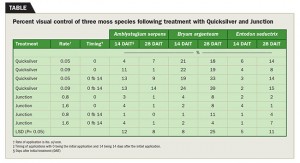Moss control in creeping bentgrass greens
Moss infestations on creeping bentgrass (Agrostis stoloniferia L.) putting greens have become an increasing problem. Demand from golfers for a more competitive playing surface, coupled with the restriction of mercury-based pesticides, has made bentgrass putting greens ideal habitats for moss (Burnell et al., 2004; Hummel 1994). Bryum argenteum (Hedw.) (Silvery-thread moss) is a common moss species found on creeping bentgrass putting greens, however, other species such as Byrum lisae, Amblystegium trichopodium and Brachythecium spp. have also been identified on bentgrass putting greens (Happ 1998). Mosses are a member of the Phylum Bryophyta. They are able to reproduce sexually via spores or from displaced fragments (Nelson 2007; Boesch and Mitkowski 2005; Yelverton 2005). They lack vascular systems and can absorb water and minerals throughout the entire plant (Boesch and Mitkowski 2005). This lack of a vascular system prevents systemic herbicides from translocating throughout the plant, making them useless for control (Yelverton 2005).
Quicksilver (carfentrazone) is a member of the aryl triazolinone family of herbicides and is labeled for the control of Bryum argenteum (Hedw.) on creeping bentgrass putting greens (Senseman 2007). It was labeled for moss control on creeping bentgrass putting greens in July 2005, and research indicates that carfentrazone provides good to excellent control of silvery-thread moss over a broad temperature spectrum (Anonymous 2005; Boesch and Mitkowski 2005; Nelson 2007; Settle et al. 2006). Junction (mancozeb + copper hydroxide), a bactericide/fungicide, is also labeled for moss control on bentgrass putting greens (Anonymous 2006). Landschoot et al. (2004) investigated Junction and concluded that summer treatments did not control Bryum argenteum, however, fall applications of 5.0 oz. /1,000 square feet applied biweekly with 5 applications provided 100 percent moss control. Cook et al. (2002) concluded that five applications of Junction applied at 0.1 to 0.15 lbs. copper/1,000 square feet biweekly controlled Bryum argenteum for up to two years. However, copper accumulation in the soil medium could potentially induce iron deficiency in turfgrass plants. (Boesch and Mitkowski 2005; Landschoot et al. 2004) Landschoot et al. (2004) observed creeping bentgrass injury with multiple applications of Junction and attributed it to copper-induced iron chlorosis. Bryum argenteum control has also been observed with other chemistries, such as ferrous and ferric sulfates and sodium carbonates. However, control is erratic and appears to be dependent on environment (Boesch and Mitkowski 2005; Landschoot et al. 2004; Turgeon and Vargas 2006).
With this wide range of control observed with moss control products, more superintendents have been utilizing Quicksilver for moss control on creeping bentgrass putting greens. Therefore, research was conducted to evaluate Quicksilver efficacy in comparison to Junction on three different moss species that are commonly found on creeping bentgrass putting greens.
Experimental information
A replicated greenhouse study was conducted to evaluate Quicksilver and Junction control of Bryum argenteum, Amblystegium serpens and Entodon seductrix in spring and summer. Moss species were collected from Gettysview CC in Knoxville, Tenn., and Gatlinburg CC in Pigeon Forge, Tenn. Moss samples were taxonomically identified and separated. Separate species were vegetatively propagated in 4-inch diameter pots and grown in 80:20 sand to reed sedge peat mix. Plants were overhead irrigated twice daily and temperatures were maintained at an average of 77 degrees F.
Treatments were applied with a CO2 pressurized backpack sprayer calibrated at 30 gals./acre. Moss species were evaluated on a 0 (no control) to 100 percent (complete control) scale 3, 7, 14, 21 and 28 days after initial treatment. All herbicide treatments are listed in Table 1. Sequential applications of treatments were made 14 days after initial treatment. The experiment started February 27th and was repeated April 30th.
Treatments included four Quicksilver treatments (0.05, 0.09 and 0.05 followed by (fb) 0.05, 0.9 fb 0.9 lbs. ai/acre) and four Junction treatments (0.8, 1.6, 0.8 fb 0.8, 1.6 fb 1.6 lbs. ai/acre). All sequential applications were made 14 days after the initial application.
Digital images were taken on each moss evaluation date (0, 3, 7, 14, 21 and 28 days after initial treatment) of each pot. Digital images were downloaded to a personal computer and analyzed to determine percent moss cover.
All data were subject to analysis of variance (P = 0.05). Data were analyzed according to the factorial arrangement. Each moss species was analyzed separately by date of observation. There was no interaction between the two studies, so data from both studies were combined and presented by observation date.
Results
Visual Moss Control. Quicksilver did not provide greater than 39 percent control of any moss species throughout this study (See table). Sequential applications of Quicksilver provided better control than single applications, especially with Amblystegium serpens. Junction provided poor control of all moss species for the duration of the experiment. The greatest control observed with Junction was 11 percent with Bryum argenteum, which was not statistically different from the untreated pots. Landschoot et al. (2004) observed minimal control of Bryum argenteum with Junction. This similar result was observed with Junction when applied sequentially and at two different rates with all three species of moss.
 Quicksilver is an effective means of Bryum argenteum control, however moss regrowth can occur if multiple applications are not made. A decrease in moss control was observed with single applications of Quicksilver when applied to Amblystegium serpens and Bryum argenteum. The decrease in moss control was attributed to moss regrowth. Quicksilver applied at the highest rate with a sequential application controlled Bryum argenteum 39 percent 28 days after initial treatment. This was the greatest visual control observed with any moss species.
Quicksilver is an effective means of Bryum argenteum control, however moss regrowth can occur if multiple applications are not made. A decrease in moss control was observed with single applications of Quicksilver when applied to Amblystegium serpens and Bryum argenteum. The decrease in moss control was attributed to moss regrowth. Quicksilver applied at the highest rate with a sequential application controlled Bryum argenteum 39 percent 28 days after initial treatment. This was the greatest visual control observed with any moss species.
All Quicksilver treatments reduced cover of Entodon seductrix, however control never exceeded >15 percent. Both Quicksilver and Junction provided minimal visual control of both Amblystegeum serpens and Entodon seductrix.
Digital Analysis Data. Digital analysis data and visual control ratings had similar trends with chemical control of all three moss species. The digital analysis confirmed the visual control ratings. Therefore, the digital analysis data are not presented.
Conclusions
When reviewing the data presented in this article, please keep in mind growing conditions were favorable for moss and there was no competition present from creeping bentgrass. Also, no cultural practices were implemented that would hinder growth of the moss or favor competiveness and growth of creeping bentgrass.
In short, conditions were nearly ideal for moss growth and regrowth. On a golf course, more than two applications of Quicksilver or Junction, together with cultural practices, would most likely provide greater moss control than reported in this article.
Quicksilver provided greater control with all three moss species than Junction. Control of all three moss species with Junction was minimal — less than 15 percent. Sequential applications of Quicksilver are required to reduce moss regrowth. Single applications of Quicksilver can increase growth rates of Bryum argenteum.
Quicksilver applications made to the other moss species stabilized growth rates but did not decrease populations. Erratic Quicksilver efficacy could potentially be attributed to diversity in moss species. Variation in moss control on putting greens among golf courses could potentially be attributed to differences in moss species.
References
Anonymous. 2006. Junction fungicide/bactericide product label. SePRO Corporation. Meridian, IN.
Anonymous. 2005. Quicksilver herbicide product label. FMC Corporation. FMC Corporation Agricultural Product Group, Philadelphia, PA.
Boesch B.P. and N.A. Mitkowski. 2005. Chemical methods of moss control on golf course putting greens. Applied Turf Science. October: 1-8.
Burnell K.D., F.H. Yelverton, J.C. Neal, T.W. Gannon, and J.S. McElroy. 2004. Control of silvery-thread moss (Bryum argenteum Hedw.) in creeping bentgrass (Agrostis palustris huds.) putting greens. Weed Tech.:18:560-565.
Cook, T., B. McDonald, and K. Merrifield. 2002. Controlling moss in putting greens. Golf Course Manag. Sept. 70(9):103-106.
Happ, K.A. 1998. Moss eradication in putting green turf. USGA Green Section Record. 36(5):1-5.
Hummel, N. W., Jr. 1994. Methods for moss control. Golf Course Manage. 64:106-110.
Landschoot, P., J. Cook, and B. Park 2004. Moss control- new products and strategies. USGA Green Section Record. 42(4):7-9.
Nelson, M. 2007. Of moss and men. Available at http://www.usga.org/turf/green_section_record/2007/jul_aug/ofmoss.html. Accessed on September 15, 2007.
Senseman, S.A. 2007. Herbicide Handbook. Weed Science Society of America ninth edition. pp.197.
Settle, D.M., R.T. Kane and G.C. Miller. 2006. Evaluation of newer products for selective control of moss on creeping bentgrass greens. USGA Turf and Environ. Research Online 6(5):1-6.
Turgeon A.J. and J.M. Vargas Jr. 2006. The Turf Problem Solver. New Jersey: John Wiley and Sons. pp. 162-163.
Yelverton, F.H. 2005. Managing silvery thread moss in creeping bentgrass greens. Golf Course Manag. Mar: 103-107.
Moss control program
Below is a moss control program that Scott McElroy, Ph.D., has developed through research and observations of successful moss control programs on golf courses that he suggests to superintendents.
- Two applications of Quicksilver at 6.7 fl. oz. per acre applied two weeks apart.
- Topdress, topdress, topdress. A light, frequent topdressing program will help reduce moss populations.
- Aerifcation will help.
- Apply sufficient nitrogen to maintain reasonable growth of creeping bentgrass.
- Quicksilver applied after a bensulide application can induce injury in creeping bentgrass.
- Junction is best used preventively rather than as a curative for moss.
Scott McElroy, Ph. D., is an associate professor at Auburn University. Steven Borst, Ph.D., is a former M.S. student with Dr. McElroy and a recent Ph.D. graduate of Louisiana State University. The research presented herein is a compilation of Dr. Borst’s M.S. research on moss biology and control in golf course putting greens. Contact Scott McElroy at jsm0010@auburn.edu.









